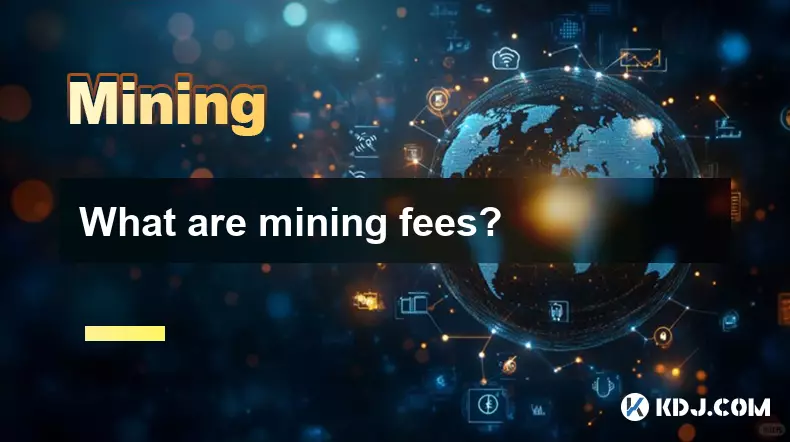-
 bitcoin
bitcoin $120167.907534 USD
1.27% -
 ethereum
ethereum $4468.611945 USD
2.53% -
 xrp
xrp $3.013607 USD
1.80% -
 tether
tether $1.000549 USD
-0.01% -
 bnb
bnb $1092.592149 USD
6.28% -
 solana
solana $231.391244 USD
4.59% -
 usd-coin
usd-coin $0.999699 USD
-0.04% -
 dogecoin
dogecoin $0.259020 USD
4.30% -
 tron
tron $0.342747 USD
0.34% -
 cardano
cardano $0.860977 USD
1.07% -
 hyperliquid
hyperliquid $50.155412 USD
5.34% -
 chainlink
chainlink $22.637678 USD
0.46% -
 ethena-usde
ethena-usde $1.000528 USD
-0.07% -
 avalanche
avalanche $30.613779 USD
-0.07% -
 stellar
stellar $0.403905 USD
0.94%
What are mining fees?
Mining fees incentivize miners to validate transactions, with higher fees prioritizing faster confirmations, especially during network congestion.
Sep 21, 2025 at 01:18 pm

Understanding Mining Fees in the Cryptocurrency Ecosystem
Mining fees are a crucial component of blockchain networks that rely on proof-of-work consensus mechanisms. These fees serve as incentives for miners who validate transactions and secure the network. When users send cryptocurrency from one wallet to another, they attach a fee to their transaction. This fee determines how quickly the transaction will be processed by miners.
Miners prioritize transactions with higher fees because they receive more compensation for including them in the next block. During periods of high network congestion, competition among users to get their transactions confirmed faster drives up the average mining fee. This dynamic pricing model ensures that the network remains functional even under heavy load, although it can make small or urgent transactions expensive during peak times.
Factors Influencing Mining Fee Levels
- Network congestion directly affects mining fees; when more people are sending transactions, the mempool (a holding area for unconfirmed transactions) becomes crowded, increasing competition.
- Transaction size in bytes plays a role—larger transactions require more data to be stored on the blockchain, so they typically incur higher fees.
- Wallet settings allow users to manually set their fee rate per byte, giving control over confirmation speed versus cost.
- Blockchain capacity limits, such as Bitcoin’s 1MB block size (or SegWit-adjusted equivalent), constrain how many transactions can be included per block, contributing to fee volatility.
- Market demand for fast confirmations, especially during bull markets or major events, leads to spikes in average fees.
The Role of Miners in Fee Collection
- Miners gather pending transactions from the mempool and select those with the most attractive fees to include in the block they are trying to mine.
- Once a miner successfully solves the cryptographic puzzle required to add a new block, they collect both the block reward and all associated transaction fees from that block.
- Fees act as a supplementary income source beyond the block subsidy, which halves periodically in systems like Bitcoin.
- As the block reward diminishes over time due to halving events, transaction fees are expected to become the primary incentive for miners to continue securing the network.
- Efficient mining pools often use advanced algorithms to maximize profitability by optimizing the selection of transactions based on fee density (fees per byte).
How Users Can Manage Mining Fees
- Many wallets provide real-time fee estimation tools that suggest optimal rates based on desired confirmation times (e.g., within 10 minutes vs. 1 hour).
- Users can choose lower fees if they are not in a hurry, accepting longer confirmation delays during busy periods.
- Some platforms support Replace-by-Fee (RBF), allowing users to increase the fee on an unconfirmed transaction to speed it up.
- Utilizing Segregated Witness (SegWit) addresses reduces transaction size, thereby lowering the total fee required.
- Layer-2 solutions like the Lightning Network enable off-chain transactions with minimal fees, reducing reliance on the main blockchain for small payments.
Frequently Asked Questions
What happens if I set a very low mining fee?If a transaction has a fee below the threshold preferred by miners, it may remain stuck in the mempool for hours or even days. Some wallets allow cancellation or replacement via RBF, but if not, the network might eventually drop the transaction.
Can mining fees be refunded?No, once a transaction is broadcast to the network, the mining fee is non-refundable—even if the transaction fails or gets dropped. The fee is paid for processing services rendered by miners.
Do all cryptocurrencies have mining fees?Not all. Proof-of-stake blockchains like Cardano or Ethereum post-merge do not use traditional mining but still charge transaction fees, which are either burned or distributed to validators rather than miners.
Why did my transaction take so long despite paying a fee?Even with a fee, delays can occur if the fee was too low relative to current network conditions. High congestion means only the highest-paying transactions get priority, pushing lower-fee ones further back in line.
Disclaimer:info@kdj.com
The information provided is not trading advice. kdj.com does not assume any responsibility for any investments made based on the information provided in this article. Cryptocurrencies are highly volatile and it is highly recommended that you invest with caution after thorough research!
If you believe that the content used on this website infringes your copyright, please contact us immediately (info@kdj.com) and we will delete it promptly.
- BlockDAG, DOGE, HYPE Sponsorship: Crypto Trends Shaping 2025
- 2025-10-01 00:25:13
- Deutsche Börse and Circle: A StableCoin Adoption Powerhouse in Europe
- 2025-10-01 00:25:13
- BlockDAG's Presale Buzz: Is It the Crypto to Watch in October 2025?
- 2025-10-01 00:30:13
- Bitcoin, Crypto, and IQ: When Genius Meets Digital Gold?
- 2025-10-01 00:30:13
- Stablecoins, American Innovation, and Wallet Tokens: The Next Frontier
- 2025-10-01 00:35:12
- NBU, Coins, and Crypto in Ukraine: A New Yorker's Take
- 2025-10-01 00:45:14
Related knowledge

The difference between staking and mining
Sep 24,2025 at 05:18am
Understanding Staking in the Cryptocurrency Ecosystem1. Staking involves holding funds in a cryptocurrency wallet to support the operations of a block...

How to participate in testnet mining?
Sep 22,2025 at 09:18am
Understanding Testnet Mining in the Crypto Ecosystem1. Testnet mining is a method used by blockchain developers to simulate real-world conditions on a...

How to dispose of abandoned mining machines?
Sep 19,2025 at 08:19pm
Assessing the Condition of Abandoned Mining Rigs1. Begin by inspecting each mining machine for visible damage, corrosion, or missing components. Machi...

How to identify high-quality mining pools?
Sep 21,2025 at 03:19pm
Reputation and Track Record1. A mining pool’s reputation is built over time through consistent performance and transparency. Pools that have operated ...

Advantages of decentralized mining pools
Sep 20,2025 at 04:36pm
Enhanced Security and Resistance to Censorship1. Decentralized mining pools operate on blockchain-based smart contracts, eliminating the need for a ce...

What is mining machine overclocking?
Sep 21,2025 at 07:19pm
Understanding Mining Machine Overclocking1. Mining machine overclocking refers to the process of increasing the operating frequency of a cryptocurrenc...

The difference between staking and mining
Sep 24,2025 at 05:18am
Understanding Staking in the Cryptocurrency Ecosystem1. Staking involves holding funds in a cryptocurrency wallet to support the operations of a block...

How to participate in testnet mining?
Sep 22,2025 at 09:18am
Understanding Testnet Mining in the Crypto Ecosystem1. Testnet mining is a method used by blockchain developers to simulate real-world conditions on a...

How to dispose of abandoned mining machines?
Sep 19,2025 at 08:19pm
Assessing the Condition of Abandoned Mining Rigs1. Begin by inspecting each mining machine for visible damage, corrosion, or missing components. Machi...

How to identify high-quality mining pools?
Sep 21,2025 at 03:19pm
Reputation and Track Record1. A mining pool’s reputation is built over time through consistent performance and transparency. Pools that have operated ...

Advantages of decentralized mining pools
Sep 20,2025 at 04:36pm
Enhanced Security and Resistance to Censorship1. Decentralized mining pools operate on blockchain-based smart contracts, eliminating the need for a ce...

What is mining machine overclocking?
Sep 21,2025 at 07:19pm
Understanding Mining Machine Overclocking1. Mining machine overclocking refers to the process of increasing the operating frequency of a cryptocurrenc...
See all articles










































































